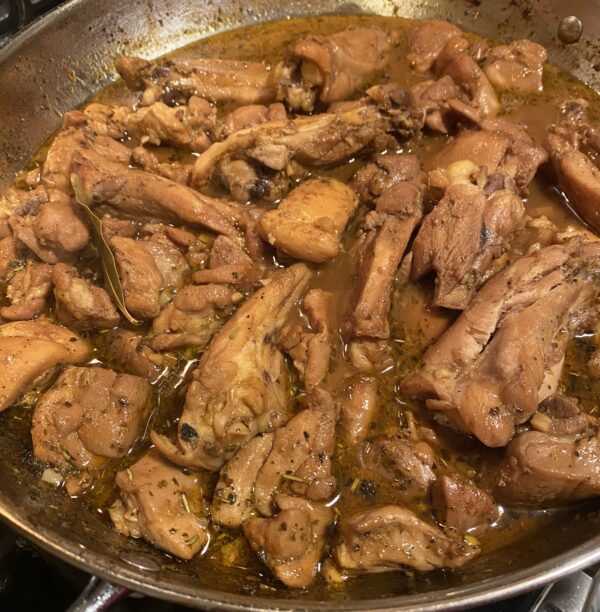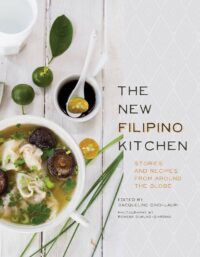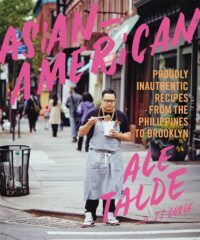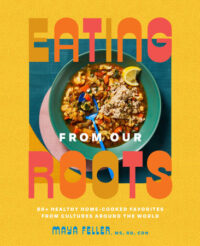
If I were to think of a right of passage into Filipino cuisine, I would have to say it’s Chicken Adobo. It is considered one of the national dishes of the Philippines, and those who have had it most likely have a favorite adobo recipe made by someone they love. For many Filipinos, chicken adobo takes them home to their parents, grandparents, or even to their auntie’s house. When I got married and had kids, I knew it was time to perfect my own signature chicken adobo.
Adobo refers to a process that involves pickling, marinading, or, in other words, braising in vinegar. There are many variations, but the basic ingredients of this meaty and saucy dish include white vinegar, garlic, soy sauce, bay leaves, and peppercorns. It can be made with chicken, pork, a combination of both, or even squid! You can also add potatoes, mushrooms, a few boiled eggs, quail eggs, and/or coconut milk. A fresh mound of hot white rice completes the meal and can be enjoyed even better on the second and third day as the flavors “adobo” together.
The following recipe is how I tailored the basic chicken adobo recipe to accommodate my family’s food allergies and tastes. It is now a comfort food for my children, and I am proud to share this soy-free version with you. Measurements are a guestimation, so please measure with your heart.
You Will Need:

Directions:
Heat the oil and sauté the garlic and ginger. Add the chicken pieces, and seasonings (garlic powder, onion powder, paprika, and Italian seasoning) and lightly brown. Add Bragg Organic Liquid Aminos, water, and bay leaves and simmer, covered for 30 minutes or until the chicken is tender. Add the vinegar and simmer until the liquid is reduced to your liking.
Serve with rice, and enjoy!
For Asian-American Pacific Islanders Heritage Month, I wanted to highlight a few Staff-picks available to borrow from CCPL to bring Filipino cuisine to your kitchen at home:
“Experience classic and authentic recipes from the Philippines with Quintessential Filipino Cooking. This incredible collection of 75 recipes highlights the traditions and favors of Filipino cooking, and gives each one Liza’s personal touch that takes it to the next level. These recipes highlight the standout favors of Austronesian, Malay-Indonesian, Indian, Japanese, Chinese, Spanish and American cuisines to make unforgettable dishes. Using easy-to-find ingredients and simple techniques Liza teaches readers to cook their own lumpia (spring rolls), sinigang (sour soup), longganisa (sausage), adobo (chicken or pork), kare kare (stewed oxtail), leche flan and more.”
–Back cover
“The New Filipino Kitchen collects 30 recipes and stories from expat Filipinos, all of whom have taken their favorite dishes with them, preserving their food memories and, if necessary, tweaking their recipes to work in a new environment or, in the case of some chefs, a more modern context.”
–Provided by Publisher
“In her debut cookbook, acclaimed chef Angela Dimayuga shares her passion for Filipino food with home cooks. Filipinx offers 100 deeply personal recipes–many of them dishes that define home for Angela Dimayuga and the more than four million people of Filipino descent in the United States”– Provided by publisher.
“Filipinx offers 100 deeply personal recipes–many of them dishes that define home for Angela Dimayuga and the more than four million people of Filipino descent in the United States. The book tells the story of how Dimayuga grew up in an immigrant family in northern California, trained in restaurant kitchens in New York City–learning to make everything from bistro fare to Asian-American cuisine–then returned to her roots, discovering in her family’s home cooking the same intense attention to detail and technique she’d found in fine dining. In this book, Dimayuga puts a fresh spin on classics: adobo, perhaps the Filipino dish best known outside the Philippines, is traditionally built on a trinity of soy sauce, vinegar, and garlic–all pantry staples–but add coconut milk, vinegar, and oil, and it turns lush and silky; ribeye steaks bring extra richness to bistek, gilded with butter and a bright splash of lemon and orange juice. These are the punches of flavor and inspired recipes that home cooks have been longing for.”
— Provided by Publisher
“The eagerly awaited cookbook from Dale Talde, Top Chef favorite and owner of the acclaimed Brooklyn restaurant Talde. Born in Chicago to Filipino parents, Dale Talde grew up both steeped in his family’s culinary heritage and infatuated with American fast food–burgers, chicken nuggets, and Hot Pockets. Today, his dual identity is etched on the menu at Talde, his always-packed Brooklyn restaurant. There he reimagines iconic Asian dishes, imbuing them with Americana while doubling down on the culinary fireworks that made them so popular in the first place. His riff on pad thai features bacon and oysters. He gives juicy pork dumplings the salty, springy exterior of soft pretzels. His food isn’t Asian fusion; it’s Asian-American. Now, in his first cookbook, Dale shares the recipes that have made him famous, all told in his inimitable voice. Some chefs cook food meant to transport you to Northern Thailand or Sichuan province, to Vietnam or Tokyo. Dale’s food is meant to remind you that you’re home.”
— Provided by Publisher
“Growing up half-Filipino, Leah Cohen never thought food from her mother’s side would become her life’s work. But after working in Michelin-starred restaurants and then competing on Top Chef, Cohen was still searching to define what made her food hers. She found the answer in Vietnam, Thailand, Myanmar, Singapore, Indonesia, and yes, the Philippines, as she rediscovered the deliciously sweet, pungent, and spicy flavors of her youth and set out to take them back with her to New York. Now, Cohen brings the exciting flavors of Southeast Asia to the masses in her beloved New York City restaurants. And in this cookbook, she shows readers how to use pantry staples like fish sauce (the salt of Southeast Asia), coconut milk, and shrimp paste to delicious effect, and gives home cooks the confidence to embrace what she calls the “controlled chaos” of Asian cooking in their own kitchens. As Cohen explains, Southeast Asian cooking varies by country, but what unites the cuisine is the balance of flavor that creates deep umami in every dish. From addictive street food snacks like Lumpia Shanghai (Filipino spring rolls) to Burmese Eggplant Salad, Grilled Cod in Banana Leaf with Yellow Curry, Crisp Banana Fritters, and even fiery cocktails, this cookbook presents authentic dishes with a modern twist. With more than 125 recipes, it will inspire home cooks to let their taste buds travel.”
— Provided by Publisher
“Eating from Our Roots is a love letter to the globe that celebrates nourishing, flavorful dishes from cultures around the world. A registered dietitian and nutritionist known for her approachable, real-food-based solutions, Maya Feller highlights the nourishing roots of foods from regions including the Caribbean, South America, Africa, the Mediterranean, Asia, and more. She shares thoughtful and realistic ways to think about how we relate to healthy foods, along with nutrition highlights and tips. The standard American Diet is known to be rich in added sugars, salts, and synthetic fats. Eating with flavor and nourishment at the center of our plates supports our health without relying on standard American patterns of eating. You can achieve health by getting back to the traditional cooking methods, with a focus on whole and minimally processed ingredients prepared with spices and flavor-enhancing techniques at home. Maya makes it easy to enjoy the vibrant flavors of your favorite cuisine, whether that’s the foods you grew up eating in the family kitchen or new recipes you’re discovering for the first time. Recipes like: Red Wine-Braised Fried Chicken with Spiced Honey from West Africa Granny’s Callaloo from Trinidad & Tobago Mezze: Cucumber Za’atar Salad, Olive Oil Labneh, and Olives from Lebanon Filipino Pork Adobo from the Philippines Biscuits with Blackberry Cayenne Jam + Chamomile Butter from the American South With more than eighty recipes and beautiful photography throughout, Eating from Our Roots is an approachable, inclusive approach to healthy cooking.”
— Provided by Publisher











